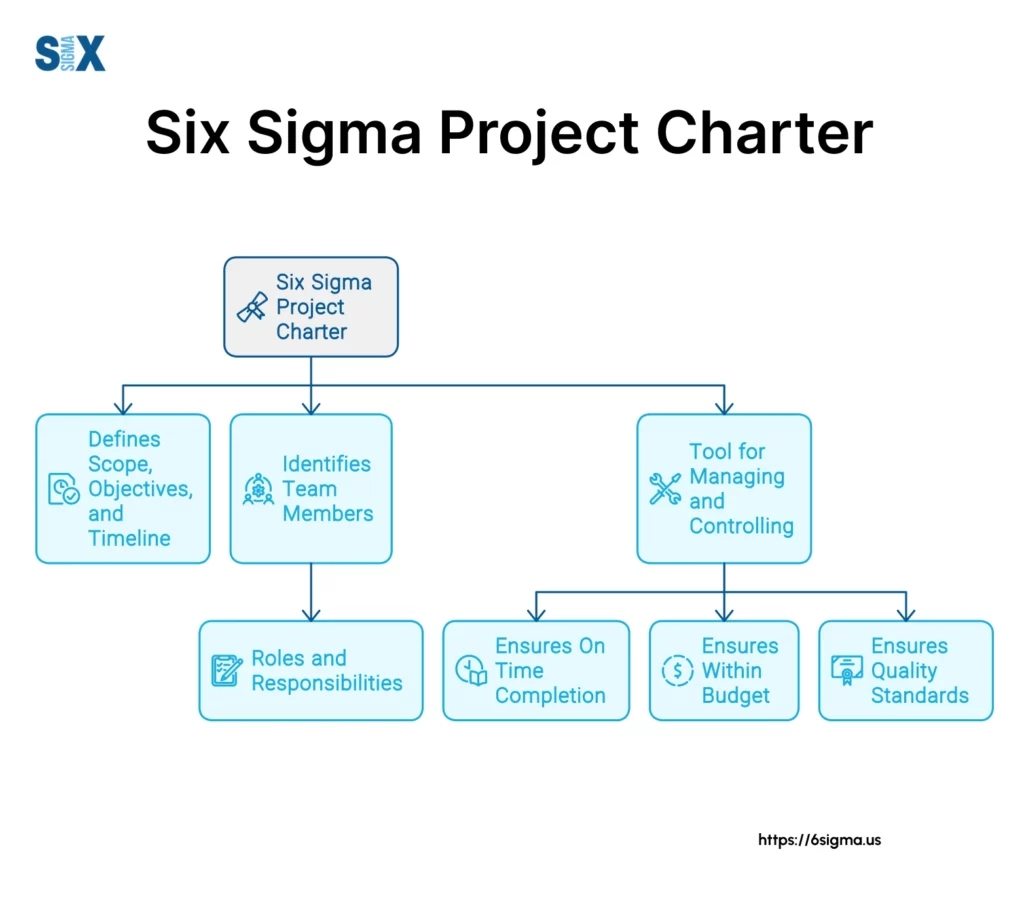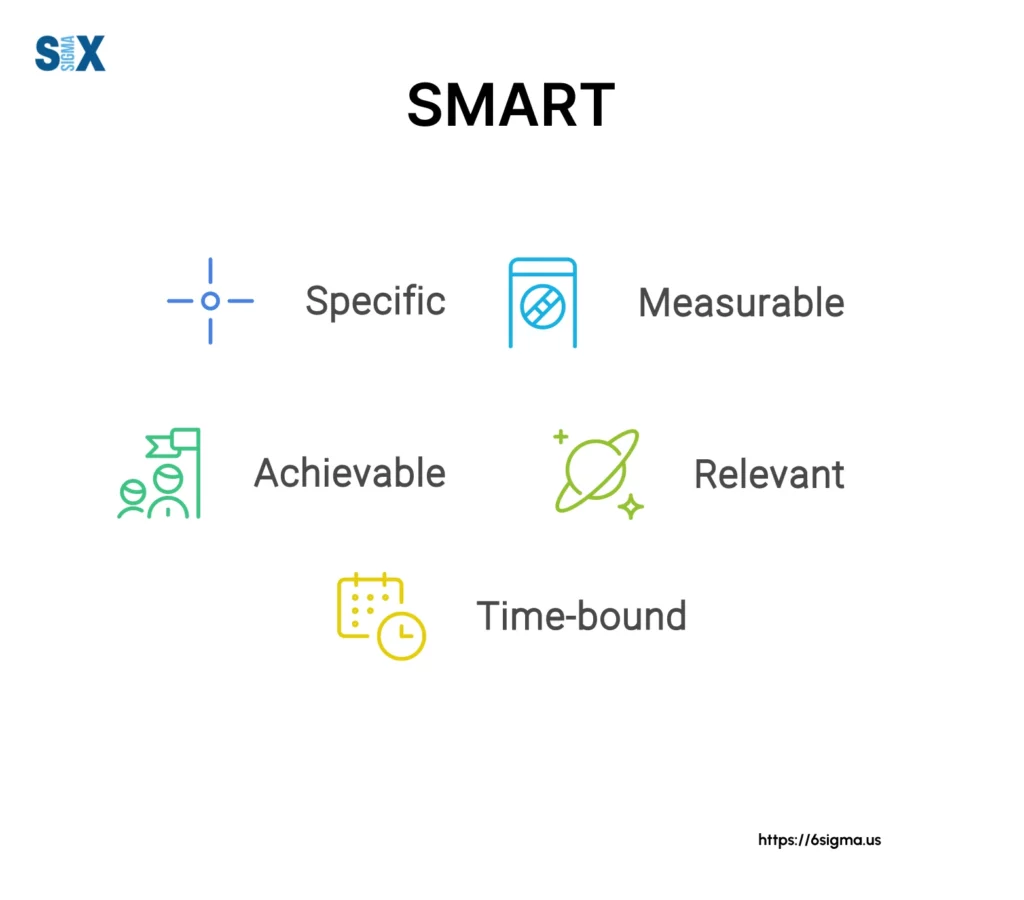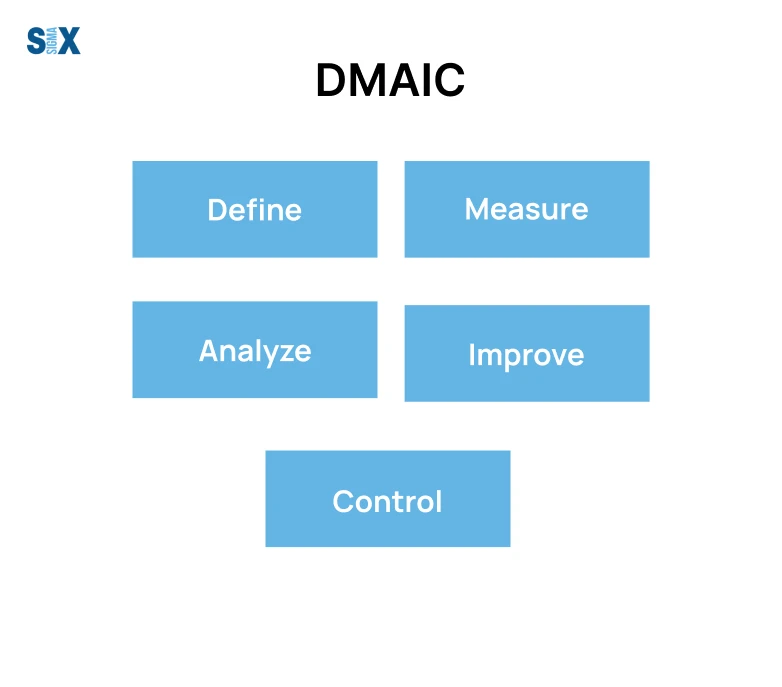Six Sigma Project Charter: Master Guide for Process Improvement Success
The Six Sigma project charter is more than just a document; it’s the foundation upon which successful projects are built.
It serves as a roadmap, aligning team members, stakeholders, and organizational goals towards a common objective.
Key Highlights
- Comprehensive overview of Six Sigma project charter components
- Strategies for creating compelling business cases
- Techniques for crafting data-driven problem statements
- SMART goal-setting for Six Sigma projects
- Best practices in scope definition and management
- Implementing DMAIC methodology in charter development
- Stakeholder management and securing project approval
- Maximizing charter impact for organizational success
Understanding the Six Sigma Project Charter
Six Sigma project charter is the cornerstone of any successful process improvement initiative.
It’s a concise document that outlines the fundamental elements of a project, serving as both a roadmap and a contract between the project team and the organization’s leadership.

The primary purpose of a Six Sigma project charter is to clearly define the project’s objectives, scope, and parameters.
It aligns stakeholders, sets expectations, and provides a reference point throughout the project lifecycle. Properly understanding and creating such charters are core skills, also developed and covered comprehensively in our six sigma certification programs.
Key Components of a Six Sigma Project Charter
A comprehensive Six Sigma project charter typically includes the following key components:
- Business case: Justifies the need for the project
- Problem statement: Clearly defines the issue to be addressed
- Goal statement: Outlines specific, measurable objectives
- Project scope: Delineates boundaries and limitations
- Timeline and milestones: Provides a high-level project schedule
- Team structure: Identifies key roles and responsibilities
- Stakeholder analysis: Lists involved parties and their interests
- Resource requirements: Outlines necessary personnel, equipment, and budget
Each of these components plays a crucial role in setting the project up for success.
Differences Between Traditional and Six Sigma Project Charter
While Six Sigma project charter share some similarities with traditional project charters, there are several key differences that set them apart:
- Data-driven approach: Six Sigma project charter emphasize quantifiable data and metrics more heavily than traditional charters.
- Process focus: Six Sigma projects are specifically geared towards process improvement, whereas traditional projects may have broader objectives.
- DMAIC methodology: Six Sigma project charter often incorporate the Define, Measure, Analyze, Improve, and Control (DMAIC) framework, which is unique to Six Sigma.
- Statistical rigor: Six Sigma projects place a greater emphasis on statistical analysis and data-driven decision making.
- Continuous improvement: While traditional projects may have a definite end, Six Sigma projects often feed into a cycle of continuous improvement.
Understanding these differences is crucial for effectively implementing Six Sigma methodologies in your organization.
Creating a Compelling Business Case with Six Sigma Project Charter
The first step in creating a compelling business case is identifying viable process improvement opportunities.
Start by examining your organization’s key performance indicators (KPIs) and looking for areas where performance falls short of expectations.
Additionally, consider conducting surveys or interviews with employees and customers to uncover pain points in your processes.
Remember, the best opportunities for improvement often lie where data indicates a problem and stakeholders express frustration.
Aligning with organizational goals
Once you’ve identified potential improvement opportunities, it’s crucial to align your project with broader organizational goals.
This alignment not only increases the likelihood of project approval but also ensures that your efforts contribute to the company’s overall strategy.
For instance, if your organization’s goal is to increase customer satisfaction, you might focus on a project that reduces response time in customer service processes.
If the goal is cost reduction, you might target a project that minimizes waste in a manufacturing process.
Quantifying Potential Financial Benefits with the Six Sigma Project Charter
To truly make your business case compelling, you need to quantify the potential financial benefits of your project.
This is where your statistical background comes into play. Use historical data and predictive modeling to estimate the financial impact of your proposed improvements.
For example, if you’re proposing a project to reduce defects in a manufacturing process, calculate the current cost of defects (including materials, labor, and potential lost sales) and estimate how much you could save by reducing defects to your target level.
Present these figures in terms of both cost savings and potential revenue increases to give a comprehensive view of the project’s financial impact.
Crafting an Effective Problem Statement
Voice of the customer (VOC) considerations
A crucial aspect of crafting an effective problem statement is incorporating the Voice of the Customer (VOC).
This ensures that your project addresses issues that truly matter to your end-users or customers.
To effectively incorporate VOC, consider using tools like surveys, focus groups, or customer complaint data.
The goal is to understand not just what customers say they want, but what they truly need.
Remember, sometimes customers can articulate their problems but not the solutions – it’s our job to translate their needs into actionable project goals.
Defining critical to quality (CTQ) factors with Six Sigma Project Charter
Once you’ve gathered VOC data, the next step is to define the Critical to Quality (CTQ) factors.
These are the key measurable characteristics of a product or process whose performance standards or specification limits must be met to satisfy the customer.
Using data to support the problem statement
Anecdotal evidence may be compelling, but hard data is convincing. Use your statistical skills to analyze relevant process data and present it in a clear, visually appealing manner.
This data-driven approach not only strengthens your problem statement but also sets the stage for measuring project success later on.
Setting Clear Goals and Objectives with Six Sigma Project Charter
SMART stands for Specific, Measurable, Achievable, Relevant, and Time-bound. Let’s break this down in the context of a Six Sigma project:

- Specific: Clearly define what you want to achieve. Instead of “improve customer satisfaction,” aim for “reduce customer complaint rate.”
- Measurable: Ensure you can quantify the goal. For example, “reduce customer complaint rate by 30%.”
- Achievable: Set ambitious but realistic goals based on your resources and constraints.
- Relevant: Align your goal with broader business objectives and stakeholder needs.
- Time-bound: Set a clear timeframe for achieving the goal, e.g., “within 6 months.”
Establishing key performance indicators (KPIs)
Once you’ve set SMART goals, the next step is to establish Key Performance Indicators (KPIs) that will help you track progress towards these goals; selecting and utilizing appropriate KPIs effectively is a key competency covered in six sigma certification programs.
KPIs should be directly related to your project objectives and CTQ factors.
For instance, if your goal is to reduce cycle time in a manufacturing process, your KPIs might include:
- Average cycle time
- Process sigma level
- Takt time
- Work in progress (WIP) inventory levels
Remember, the key is to choose KPIs that are meaningful, measurable, and actionable.
Outlining project deliverables for Six Sigma Project Charter
Finally, clearly outline the tangible outputs or deliverables expected from your project. These should be directly linked to your project goals and KPIs. Deliverables might include:
- A new process map
- Updated standard operating procedures
- A statistical model for predicting defects
- A control plan for maintaining improvements
By clearly defining these deliverables upfront, you set clear expectations for what the project will produce and provide a concrete way to measure project completion.
Defining Project Scope and Boundaries
A well-defined scope is crucial for project success. In my experience working with companies like GE and Dow.
- Be specific: Clearly state what the project will and will not do.
- Use measurable terms: Include quantifiable metrics where possible.
- Align with goals: Ensure the scope directly supports your project objectives.
- Consider constraints: Account for time, budget, and resource limitations.
- Get stakeholder agreement: Ensure all key stakeholders understand and approve the scope.
Identifying in-scope and out-of-scope elements
One effective way to define your project scope is to explicitly list what’s in-scope and what’s out-of-scope. This helps prevent misunderstandings and scope creep later in the project. For example:
In-scope
- Analyzing the current order fulfillment process
- Identifying bottlenecks in the process
- Implementing process improvements in the packaging department
Out-of-scope
- Changes to the order entry system
- Modifications to shipping carrier contracts
- Improvements in the customer service department
Managing scope creep in Six Sigma project charter
Scope creep is a common challenge in Six Sigma projects. As you uncover more about the process, it’s tempting to expand the project scope.
However, this can lead to delays, budget overruns, and ultimately, project failure. Here are some strategies I’ve used to manage scope creep:
- Regularly review the project charter: Keep the team focused on the original objectives.
- Implement a change control process: Any proposed changes to the scope should go through a formal review and approval process.
- Educate stakeholders: Help them understand the importance of maintaining scope boundaries.
- Document out-of-scope requests: Keep a log of these for potential future projects.
- Use the DMAIC methodology: This structured approach helps keep the project on track.
Planning Timeline, Milestones, and Resources
Creating a realistic timeline is crucial for project success. Here’s how to approach it:
- Break down the project into phases: Use the DMAIC methodology (Define, Measure, Analyze, Improve, Control) as a framework.
- Estimate duration for each phase: Consider the complexity of tasks and availability of resources.
- Account for dependencies: Some tasks may need to be completed before others can start.
- Build in buffer time: Allow for unexpected delays or complications.
- Use project management tools: Gantt charts or critical path analysis can be helpful.
Remember, it’s better to slightly overestimate and deliver early than to underestimate and miss deadlines.
Setting major milestones and checkpoints for Six Sigma Project Charter
Milestones and checkpoints are crucial for tracking progress and maintaining momentum. They provide natural points for review and course correction if needed.
Based on the DMAIC methodology, here are some typical milestones for a Six Sigma project:
- Project charter approved (Define phase)
- Data collection plan completed (Measure phase)
- Root cause analysis finished (Analyze phase)
- Improvement plan developed (Improve phase)
- Control plan implemented (Control phase)
Between these major milestones, set regular checkpoints (e.g., weekly team meetings) to ensure steady progress.
Resource allocation and team structure
Effective resource allocation is critical for project success. This includes both human resources and material resources. When structuring your team, consider the following roles:
- Project Sponsor: Typically a senior executive who champions the project
- Black Belt or Green Belt: The project leader responsible for day-to-day management
- Process Owner: The person responsible for the process being improved
- Team Members: Individuals with relevant expertise or involvement in the process
- Subject Matter Experts (SMEs): Specialists who can provide deep insights into specific areas
Remember to also account for any necessary equipment, software, or other material resources in your planning.
Implementing the DMAIC Methodology in Your Six Sigma Project Charter

The Define phase is where your Six Sigma project charter really takes shape.
Key activities include:
- Clarifying the business case
- Drafting the problem statement
- Setting project goals and objectives
- Defining the project scope
- Identifying key stakeholders
- Forming the project team
Remember, the charter is a living document. While these elements are defined now, they may be refined as you progress through the project.
Measure phase planning
The Measure phase is crucial for establishing baseline performance and validating the problem statement. In your charter, outline your plans for:
- Identifying key metrics (linked to your CTQ factors)
- Developing a data collection plan
- Determining sample size and sampling method
- Validating measurement systems
- Establishing baseline process performance
By including these elements in your charter, you set clear expectations for the data-driven approach that is fundamental to Six Sigma.
Analyze, Improve, and Control considerations
While the bulk of these phases will occur after the charter is approved, it’s important to include high-level plans for these phases in your charter:
Analyze:
- Outline potential analytical tools you might use (e.g., hypothesis testing, root cause analysis, regression analysis)
- Identify any specialized software or resources needed
Improve:
- Describe the approach for generating and evaluating improvement ideas
- Plan for piloting improvements before full implementation
Control:
- Outline how you’ll ensure improvements are sustained
- Plan for documenting new processes and training staff
By including these considerations in your charter, you demonstrate a comprehensive understanding of the entire DMAIC process and set the stage for a successful project.
Six Sigma project charters often incorporate the Define, Measure, Analyze, Improve, and Control (DMAIC) framework, a core component of Six Sigma certification programs that equip practitioners with structured problem-solving skills.
Stakeholder Management and Six Sigma Project Charter Approval
Stakeholder management is often the difference between project success and failure. Start by conducting a thorough stakeholder analysis:
- Identify all stakeholders: This includes anyone who can affect or is affected by the project.
- Assess their interest and influence: Use a power/interest grid to visualize this.
- Understand their expectations: What does each stakeholder hope to gain from the project?
- Determine their potential concerns: What might cause them to resist the project?
- Plan your engagement strategy: How will you communicate with and involve each stakeholder?
Securing project sponsor support
The project sponsor is typically a senior executive who champions your project at the highest levels of the organization. Securing their full support is crucial.
Here’s how to approach this:
- Align the project with their priorities: Show how the project supports their goals and objectives.
- Speak their language: Focus on business impacts rather than technical details.
- Be clear about what you need: Whether it’s resources, authority, or simply their visible support.
- Address potential risks upfront: Show that you’ve thought through potential challenges.
- Agree on regular check-ins: This keeps them engaged and allows for course corrections if needed.
Remember, a strong relationship with your sponsor can help overcome many obstacles during the project.
Six Sigma Project Charter approval process and next steps
The charter approval process varies by organization, but typically involves presenting the charter to a steering committee or senior leadership team.
Here are some tips for a successful approval process:
- Prepare a concise presentation: Highlight key points from the charter.
- Anticipate questions: Prepare answers to likely queries about ROI, resource requirements, and potential risks.
- Be ready to negotiate: Some elements of the charter may need adjustment based on feedback.
- Secure formal sign-off: Ensure all necessary parties officially approve the charter.
Once approved, your next steps should include:
- Communicating the approved charter to all stakeholders
- Scheduling a project kick-off meeting
- Beginning the detailed planning for the Measure phase
Remember, charter approval is not the end, but the beginning of your Six Sigma journey.
Maximizing the Impact of Your Six Sigma Project Charter
As we wrap up this comprehensive guide, let’s recap the key elements that make a Six Sigma project charter successful:
- A clear, data-driven problem statement
- SMART goals aligned with organizational objectives
- Well-defined scope with clear boundaries
- Realistic timeline and resource allocation
- Stakeholder buy-in, especially from the project sponsor
- Incorporation of the DMAIC methodology
- Flexibility to adapt as the project progresses
A well-crafted charter sets the foundation for project success. It’s worth investing time and effort to get it right.
A well-crafted project charter can transform not just individual processes, but entire organizational cultures.
By mastering the art of creating effective Six Sigma project charter, you’re not just setting yourself up for project success – you’re positioning your organization for long-term, sustainable improvement and growth.
In Six Sigma, our journey of improvement never truly ends.
Each project, each charter, is a step towards operational excellence. So, take these insights, apply them to your next project, and watch as your organization reaps the benefits of your well-planned, meticulously executed Six Sigma initiatives.
SixSigma.us offers both Live Virtual classes as well as Online Self-Paced training. Most option includes access to the same great Master Black Belt instructors that teach our World Class in-person sessions. Sign-up today!
Virtual Classroom Training Programs Self-Paced Online Training Programs







